
Ice fishing
Encyclopedia
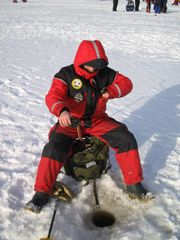
Fishing
Fishing is the activity of trying to catch wild fish. Fish are normally caught in the wild. Techniques for catching fish include hand gathering, spearing, netting, angling and trapping....
with lines and fish hook
Fish hook
A fish hook is a device for catching fish either by impaling them in the mouth or, more rarely, by snagging the body of the fish. Fish hooks have been employed for centuries by fishermen to catch fresh and saltwater fish. In 2005, the fish hook was chosen by Forbes as one of the top twenty tools...
s or spears through an opening in the ice
Ice
Ice is water frozen into the solid state. Usually ice is the phase known as ice Ih, which is the most abundant of the varying solid phases on the Earth's surface. It can appear transparent or opaque bluish-white color, depending on the presence of impurities or air inclusions...
on a frozen body of water
Water
Water is a chemical substance with the chemical formula H2O. A water molecule contains one oxygen and two hydrogen atoms connected by covalent bonds. Water is a liquid at ambient conditions, but it often co-exists on Earth with its solid state, ice, and gaseous state . Water also exists in a...
. Ice anglers may sit on the stool in the open on a frozen lake, or in a heated cabin on the ice, some with bunks and amenities.
Locations
It is a popular pastime inCanada
Canada
Canada is a North American country consisting of ten provinces and three territories. Located in the northern part of the continent, it extends from the Atlantic Ocean in the east to the Pacific Ocean in the west, and northward into the Arctic Ocean...
, Iceland
Iceland
Iceland , described as the Republic of Iceland, is a Nordic and European island country in the North Atlantic Ocean, on the Mid-Atlantic Ridge. Iceland also refers to the main island of the country, which contains almost all the population and almost all the land area. The country has a population...
, Norway
Norway
Norway , officially the Kingdom of Norway, is a Nordic unitary constitutional monarchy whose territory comprises the western portion of the Scandinavian Peninsula, Jan Mayen, and the Arctic archipelago of Svalbard and Bouvet Island. Norway has a total area of and a population of about 4.9 million...
, Sweden
Sweden
Sweden , officially the Kingdom of Sweden , is a Nordic country on the Scandinavian Peninsula in Northern Europe. Sweden borders with Norway and Finland and is connected to Denmark by a bridge-tunnel across the Öresund....
, Finland
Finland
Finland , officially the Republic of Finland, is a Nordic country situated in the Fennoscandian region of Northern Europe. It is bordered by Sweden in the west, Norway in the north and Russia in the east, while Estonia lies to its south across the Gulf of Finland.Around 5.4 million people reside...
, Estonia
Estonia
Estonia , officially the Republic of Estonia , is a state in the Baltic region of Northern Europe. It is bordered to the north by the Gulf of Finland, to the west by the Baltic Sea, to the south by Latvia , and to the east by Lake Peipsi and the Russian Federation . Across the Baltic Sea lies...
, Latvia
Latvia
Latvia , officially the Republic of Latvia , is a country in the Baltic region of Northern Europe. It is bordered to the north by Estonia , to the south by Lithuania , to the east by the Russian Federation , to the southeast by Belarus and shares maritime borders to the west with Sweden...
, Lithuania
Lithuania
Lithuania , officially the Republic of Lithuania is a country in Northern Europe, the biggest of the three Baltic states. It is situated along the southeastern shore of the Baltic Sea, whereby to the west lie Sweden and Denmark...
, Poland
Poland
Poland , officially the Republic of Poland , is a country in Central Europe bordered by Germany to the west; the Czech Republic and Slovakia to the south; Ukraine, Belarus and Lithuania to the east; and the Baltic Sea and Kaliningrad Oblast, a Russian exclave, to the north...
, Ukraine
Ukraine
Ukraine is a country in Eastern Europe. It has an area of 603,628 km², making it the second largest contiguous country on the European continent, after Russia...
, Russia
Russia
Russia or , officially known as both Russia and the Russian Federation , is a country in northern Eurasia. It is a federal semi-presidential republic, comprising 83 federal subjects...
, Germany
Germany
Germany , officially the Federal Republic of Germany , is a federal parliamentary republic in Europe. The country consists of 16 states while the capital and largest city is Berlin. Germany covers an area of 357,021 km2 and has a largely temperate seasonal climate...
, Northern China and the United States
United States
The United States of America is a federal constitutional republic comprising fifty states and a federal district...
.
Shelters
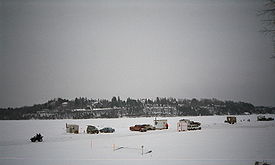
Longer fishing expeditions can be mounted with simple structures. Larger, heated structures can make multi-day fishing trips possible.
A structure with various local names, but often called an ice shanty
Ice shanty
An ice shanty is a portable shed placed on a frozen lake to provide shelter during ice fishing...
, ice shack, fish house, shack, bobhouse, or ice hut, is sometimes used. These are dragged or trailered onto the lake using a vehicle such as a snowmobile
Snowmobile
A snowmobile, also known in some places as a snowmachine, or sled,is a land vehicle for winter travel on snow. Designed to be operated on snow and ice, they require no road or trail. Design variations enable some machines to operate in deep snow or forests; most are used on open terrain, including...
, ATV
All-terrain vehicle
An all-terrain vehicle , also known as a quad, quad bike, three wheeler, or four wheeler, is defined by the American National Standards Institute as a vehicle that travels on low pressure tires, with a seat that is straddled by the operator, along with handlebars for steering control...
or truck
Pickup truck
A pickup truck is a light motor vehicle with an open-top rear cargo area .-Definition:...
. The two most commonly used types are portable and permanent. The portable houses are often made of a heavy material that is usually watertight. The two most common types of portable houses are those with a shelter that flips behind the user when not needed, or pop up shelters with a door as the only way out. The permanent shelters are made of wood or metal and usually have wheels for easy transport. They can be as basic as a bunk heater and holes or have satellite television, bathrooms, stoves, full-size beds and may appear to be more like a mobile home than a fishing house.
In North America
North America
North America is a continent wholly within the Northern Hemisphere and almost wholly within the Western Hemisphere. It is also considered a northern subcontinent of the Americas...
, ice fishing is often a social activity. Some resorts have fish houses that are rented out by the day; often, shuttle service by Snow Track or other vehicles modified to drive on ice is provided.
In Finland, solitary and contemplative isolation is often the object of the pastime. In Finland, fishhouses are a rare occurrence, but wearing a sealed and insulated drysuit designed with space-age fabric is not.
In North America, portable houses appear to create a city at locations where fishing is best.
Fishing equipment
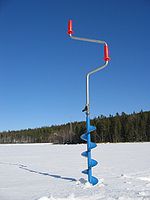
Saw
A saw is a tool that uses a hard blade or wire with an abrasive edge to cut through softer materials. The cutting edge of a saw is either a serrated blade or an abrasive...
, auger
Auger
An auger is a drilling device, or drill bit, that usually includes a rotating helical screw blade called a "flighting" to act as a screw conveyor to remove the drilled out material...
or chisel is used to cut a circular or rectangular hole in the ice. The size of the hole generally suggested is 8 inches (20 cm). Power augers are sometimes used. If these tools are not available, an axe may be used to chop the hole. A skimmer, a large metal spoon with holes in it, is used to remove new ice as it forms and to clear slush left from making the hole. During colder periods most ice anglers choose to carry a heater of some type. The heater is not only for warmth but it also for keeping an angler's fishing hole from freezing. When temperatures fall to -20 °F (-29 °C) or colder it becomes very hard to keep a fishing hole open.
Three main types of fishing occur. The first is using a small, light fishing rod with small, brightly coloured lures or jigs with bait such as wax worms, fat heads or crappie or shiner minnows. The angler sits at the hole in the ice and lifts the pole every now and then, producing the jig effect.
The second is using Tip-ups, which are made of wood or plastic, and have a spool of line attached, with a thin piece of metal that goes from the spool to the flag. Black line is put on the spool and a swivel is placed at the end of the black line. Then a piece of fishing line with a hook is attached to the swivel. Worms, power bait, grub worms or small minnows are placed on the hook. The hook with bait is paced into the water under the ice. The depth that the bait is placed goes according to several theories. One theory is the bait is placed one metre under the ice. The second is that the bait is placed two to three metres under the ice. The third is that the bait is suspended one foot (30 cm) above the bottom of the lake. When the fish strikes the bait the flag is lifted which notifies the angler that he has a fish on the hook. The angler pulls the line in and the fish fights. The angler will allow the line to slip through his hands during the struggle. Finally when the angler can get the fish's head into the hole in the ice, the fish is quickly lifted onto the ice. This allows for less-intensive fishing.
The third method is spear
Spearfishing
Spearfishing is an ancient method of fishing that has been used throughout the world for millennia. Early civilizations were familiar with the custom of spearing fish from rivers and streams using sharpened sticks....
fishing. A large hole is cut in the ice and fish decoy
Decoy
A decoy is usually a person, device or event meant as a distraction, to conceal what an individual or a group might be looking for. Decoys have been used for centuries most notably in game hunting, but also in wartime and in the committing or resolving of crimes.-Duck decoy:The term duck decoy may...
s may be deployed. The angler sits in a dark ice shanty called a dark house. The angler then peers into the water while holding a large spear which has four or five points. A line can be attached to the points. The fisherman waits for fish to appear, then plunges the spear into the water. This method is often used for lake sturgeon
Lake sturgeon
The lake sturgeon is a North American temperate freshwater fish, one of about 20 species of sturgeon. Like other sturgeons, this species is an evolutionarily ancient bottomfeeder with a partly cartilaginous skeleton and skin bearing rows of bony plates...
fishing. In the United States many states allow only rough fish
Rough fish
Rough fish is a term used by U.S. state agencies and U.S. anglers to describe fish that are less desirable to sport anglers within a limited region. The term usually refers to larger fish species that are not commonly eaten, are too rare to be commonly encountered, or are not sought after by...
to be taken while spear fishing.
Becoming increasingly popular is the use of a flasher, similar to its summer cousin the fishfinder
Fishfinder
A fishfinder is an instrument used to locate fish underwater by detecting reflected pulses of sound energy, as in SONAR. A modern fishfinder displays measurements of reflected sound on a graphical display, allowing an operator to interpret information to locate schools of fish, underwater debris,...
. This is a sonar
Sonar
Sonar is a technique that uses sound propagation to navigate, communicate with or detect other vessels...
system that provides depth information, as well as indicating the presence of fish or other objects. These flashers, unlike most typical fishfinders, display the movement of fish and other objects almost instantaneously. The bait being used can often be seen as a mark on the flasher, enabling the angler to position the bait right in front of the fish. Underwater cameras are also now available which allow the user to view the fish and observe their reaction to the lure presentation.
Modern ice fishing
Ice fishing methods have changed drastically over the past 20 years. The name of the game is Mobility for today’s modern ice anglers. The days of drilling one hole, waiting and hoping that a fish will swim by, are starting to fade. With light gear, battery-operated sonar units, and fast and powered augers, an angler can conceivably drill and check hundreds of holes in a single day. When the fish stop biting where they are, anglers can move to the next hole, checking it with their sonar first to look for activity, and if there are no fish they will keep moving until fish are found. In addition, schools of fish tend to move around; so a hole may be productive for 10 minutes and then slow down to nothing for an hour before a school returns to that location. This "fish where the fish are" technique and ease of mobility increases the catch rate of any angler, because it minimizes the wait between bites, similar to "trolling" in summer.Anglers can now use many available maps and surveys to help pinpoint lakes and areas within those lakes that make sense to try for specific fish, noting those locations in latitude and longitude coordinates. They are then able to use a handheld GPS receiver to aim them to those spots, usually with accuracy of less than 20 feet. Ice anglers then drill holes with whichever auger they have, checking the ice thickness for safety as they go. Using sonar, the angler can determine the depth of the water, bottom content, weed and structure cover, and even see if there are fish there. Also, by using sonar, they can place the bait according to where they think the fish are. If they are using "tip-ups" they can carpet the area at different depths and with different presentations (the number allowed being determined by local laws) and see what is the most productive. Modern ice anglers can also use modern reels mounted on shorter (18"-36"/45–90 cm long) fishing rods to actively fish by watching, by using their sonar, where their lure is relative to the fish, and jig accordingly to entice a bite.
Ice fishing can be done at any time of day, and is typically most active around dusk and dawn. Different fish are active at different times of day, so anglers need to fish for them accordingly. There are fishhouses large enough and comforable enough to spend many days in a row out on the lake, fishing the entire time. One can even fish in one's sleep, by using audible alarms on one's lines to tell when a fish is biting. There are also many lightweight and highly mobile portable shelters that mount on plastic sleds and collapse for transportation. These can vary from small, one-person shelters (commonly and affectionably called "Fish Traps") to large and complex shelters able to fit up to 6 people at once.
Dangers
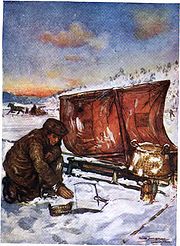
Great Lakes
The Great Lakes are a collection of freshwater lakes located in northeastern North America, on the Canada – United States border. Consisting of Lakes Superior, Michigan, Huron, Erie, and Ontario, they form the largest group of freshwater lakes on Earth by total surface, coming in second by volume...
, offshore winds can break off miles-wide pans of ice stranding large numbers of fishermen. Just such a circumstance occurred in Lake Erie in February 2009, with 100 fisherman having to be rescued by helicopters, local authorities and the Coast Guard, and one man who had fallen into the water dying on the rescue flight.
Late-winter warm spells can destroy the texture of the ice, which, while still of the required thickness, will not adequately support weight. It is called "rotten ice" or soft ice and is exceedingly dangerous. Some ice anglers will continue to fish, since even with the bad ice normally 8 inches (20 cm) is more than enough. Fisherman may carry a self-rescue device made of two spiked handles connected by a string to pull themselves out of the water and onto the ice.
Many cars, trucks, SUVs, snowmobiles, and fish houses fall through the ice each year. Current environmental regulations require the speedy recovery of the vehicle or structure in this situation. Divers must be hired, and when the trouble occurs far from shore, helicopter
Helicopter
A helicopter is a type of rotorcraft in which lift and thrust are supplied by one or more engine-driven rotors. This allows the helicopter to take off and land vertically, to hover, and to fly forwards, backwards, and laterally...
s may be employed for hoisting.
Other risks associated with ice fishing include carbon monoxide poisoning
Carbon monoxide poisoning
Carbon monoxide poisoning occurs after enough inhalation of carbon monoxide . Carbon monoxide is a toxic gas, but, being colorless, odorless, tasteless, and initially non-irritating, it is very difficult for people to detect...
from fish house heaters and frostbite due to prolonged exposure to wind and low temperatures, although most new houses are fitted with air exchange systems that allow air flow, preventing poisoning.
Contests
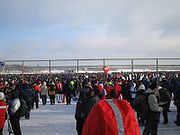
The current world's largest contest is held on Gull Lake
Gull Lake (Cass County, Minnesota)
Gull Lake is a lake in the U.S. state of Minnesota, located in Cass County and Crow Wing County. It is one of the largest lakes in the Brainerd, Minnesota-Baxter, Minnesota area and also one of the most popular. Of the seven Gull Lakes in Minnesota, this Gull Lake is the largest in area and...
, north of Brainerd, Minnesota
Brainerd, Minnesota
Brainerd is a city in Crow Wing County, Minnesota, United States. The population was 13,590 at the 2010 census. It is the county seat of Crow Wing County and one of the largest cities in Central Minnesota...
, in January of each year. The contest has over 15,000 anglers and drills over 20,000 holes for the contest.
Lake Simcoe
Lake Simcoe
Lake Simcoe is a lake in Southern Ontario, Canada, the fourth-largest lake wholly in the province, after Lake Nipigon, Lac Seul, and Lake Nipissing. At the time of the first European contact in the 17th century the lake was called Ouentironk by the Huron natives...
in Canada has abundant coldwater fish such as lake trout
Lake trout
Lake trout is a freshwater char living mainly in lakes in northern North America. Other names for it include mackinaw, lake char , touladi, togue, and grey trout. In Lake Superior, they can also be variously known as siscowet, paperbellies and leans...
, herring
Herring
Herring is an oily fish of the genus Clupea, found in the shallow, temperate waters of the North Pacific and the North Atlantic oceans, including the Baltic Sea. Three species of Clupea are recognized. The main taxa, the Atlantic herring and the Pacific herring may each be divided into subspecies...
and whitefish
Whitefish
Whitefish or white fish may refer to:In fishing terminology:* Whitefish , a fisheries term referring to the flesh of many types of fishIn fish species:...
. It is sometimes known as Canada's ice fishing capital.
In Hwacheon, South Korea
South Korea
The Republic of Korea , , is a sovereign state in East Asia, located on the southern portion of the Korean Peninsula. It is neighbored by the People's Republic of China to the west, Japan to the east, North Korea to the north, and the East China Sea and Republic of China to the south...
, a large ice fishing festival is held every January. The Ice Festival draws nearly a million visitors every year, and thousands of people have taken part in a contest to catch fish in a frozen Hwacheoncheon(a tributary of the Han River
Han River (Korea)
The Han River is a major river in South Korea and the fourth longest river on the Korean peninsula after the Amnok, Duman, and Nakdong rivers. It is formed by the confluence of the Namhan River , which originates in Mount Daedeok, and the Bukhan River , which originates on the slopes of Mount...
).

